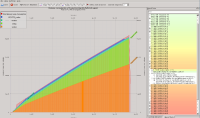Massif is an awesome Valgrind tool when it comes to profile heap usage of a program. Basically, it analyses during the process’s life how many heap memory has been allocated, and the functions responsible of the allocations.
If you were not aware of Massif, please do yourself a favor and take a glance at the documentation
ms_print
A Perl script (well commented) bundled with Valgrind.
The histogram:
- x-axis: number of executed instructions (452.0Mi = 452 millions instructions), default unit, can be overridden to use time instead
- y-axis: memory consumption (here we had a heap size peak of 664.5KB)
- vertical bars are the snapshots taken
KB
664.5^ #
| #
| :@:@:#
| ::::@::@:@:@:@:#
| :@::::::::: :@::@:@:@:@:#
| :::@@@@@@:@: :: : :: :@::@:@:@:@:#
| ::::::::::@ @ @ :@: :: : :: :@::@:@:@:@:#
| :@@@::::::: ::::@ @ @ :@: :: : :: :@::@:@:@:@:#
| ::::@:::@@ : ::::: ::::@ @ @ :@: :: : :: :@::@:@:@:@:#
| ::::: : @: :@@ : ::::: ::::@ @ @ :@: :: : :: :@::@:@:@:@:#
| @@::@::::: : @: :@@ : ::::: ::::@ @ @ :@: :: : :: :@::@:@:@:@:#
| ::@ : @::::: : @: :@@ : ::::: ::::@ @ @ :@: :: : :: :@::@:@:@:@:#
| :::: @ : @::::: : @: :@@ : ::::: ::::@ @ @ :@: :: : :: :@::@:@:@:@:#
| : :: @ : @::::: : @: :@@ : ::::: ::::@ @ @ :@: :: : :: :@::@:@:@:@:#
| : :: @ : @::::: : @: :@@ : ::::: ::::@ @ @ :@: :: : :: :@::@:@:@:@:#
| : :: @ : @::::: : @: :@@ : ::::: ::::@ @ @ :@: :: : :: :@::@:@:@:@:#
| : :: @ : @::::: : @: :@@ : ::::: ::::@ @ @ :@: :: : :: :@::@:@:@:@:#
| ::: :: @ : @::::: : @: :@@ : ::::: ::::@ @ @ :@: :: : :: :@::@:@:@:@:#
| ::: :: @ : @::::: : @: :@@ : ::::: ::::@ @ @ :@: :: : :: :@::@:@:@:@:#
| ::: :: @ : @::::: : @: :@@ : ::::: ::::@ @ @ :@: :: : :: :@::@:@:@:@:#
0 +----------------------------------------------------------------------->Mi
0 452.0
(...)
After the histogram every snapshot is explained in details. The tree structure makes easy to see how memory allocations breaks down over allocating functions.
Extract of the first snapshot:
77.83% (265,799B) (heap allocation functions) malloc/new/new[], --alloc-fns, etc.
->40.31% (137,664B) 0x4E6230F: xcalloc (alloc.c:51)
| ->20.03% (68,400B) 0x4E9D4F0: PrependItem (item_lib.c:297)
| | ->20.01% (68,352B) 0x4E62756: PrependAlphaList (alphalist.c:127)
| | | ->20.01% (68,352B) 0x4E757B1: NewClass (env_context.c:422)
| | | ->19.41% (66,288B) 0x4E7E7D6: ModuleProtocol (evalfunction.c:4168)
| | | | ->19.41% (66,288B) 0x409EB1: VerifyExec (verify_exec.c:252)
| | | | ->19.41% (66,288B) 0x40A409: VerifyExecPromise (verify_exec.c:50)
| | | | ->19.41% (66,288B) 0x4073FF: KeepAgentPromise (cf-agent.c:1102)
| | | | ->19.41% (66,288B) 0x4E8131B: ExpandPromiseAndDo (expand.c:713)
| | | | ->19.41% (66,288B) 0x4E81640: ExpandPromise (expand.c:140)
| | | | ->19.41% (66,288B) 0x40864C: ScheduleAgentOperations (cf-agent.c:921)
| | | | ->19.41% (66,288B) 0x406B9D: main (cf-agent.c:866)
| | | |
| | | ->00.60% (2,064B) in 1+ places, all below ms_print's threshold (01.00%)
| | |
| | ->00.01% (48B) in 1+ places, all below ms_print's threshold (01.00%)
| |
| ->19.19% (65,536B) 0x4E9B882: HashInsertElement (hashes.c:95)
:
(...)
What does 77.83% (265,799B) on the first line stands for ? Why not 100% ? The recapitulation table above the histogram (also given by ms_print) helps to understand:
--------------------------------------------------------------------------------
n time(i) total(B) useful-heap(B) extra-heap(B) stacks(B)
--------------------------------------------------------------------------------
0 0 0 0 0 0
1 8,880,356 584 568 16 0
2 13,579,590 123,184 80,499 42,685 0
3 21,801,661 124,000 81,305 42,695 0
4 32,406,685 272,680 213,796 58,884 0
5 41,997,645 298,440 233,116 65,324 0
6 52,656,592 319,960 249,369 70,591 0
7 60,273,737 332,920 259,251 73,669 0
8 65,706,612 341,520 265,799 75,721 0
77.83% (265,799B) is the useful-heap part of total (341,520) heap size. extra-heap is the overhead involved by memory management (housekeeping structures, …)
Massif Visualizer
Massif Visualizer is a neat-looking GUI interface:
Each snapshot is accessible through the list widget on the right, and once selected, highlight its own area over the graph. Links:
Notes
If you are aware of another Massif reports visualizer, please leave a comment!
